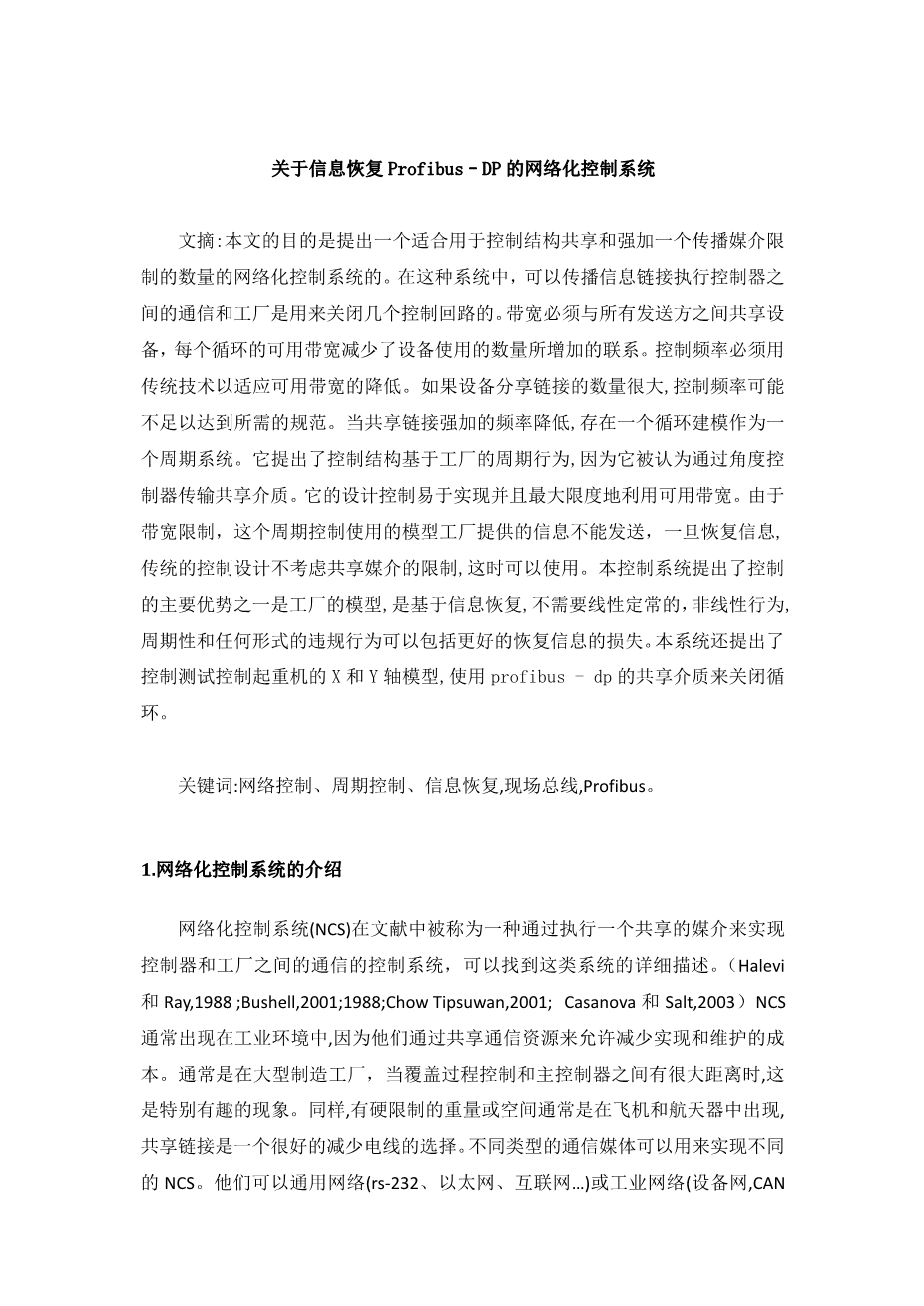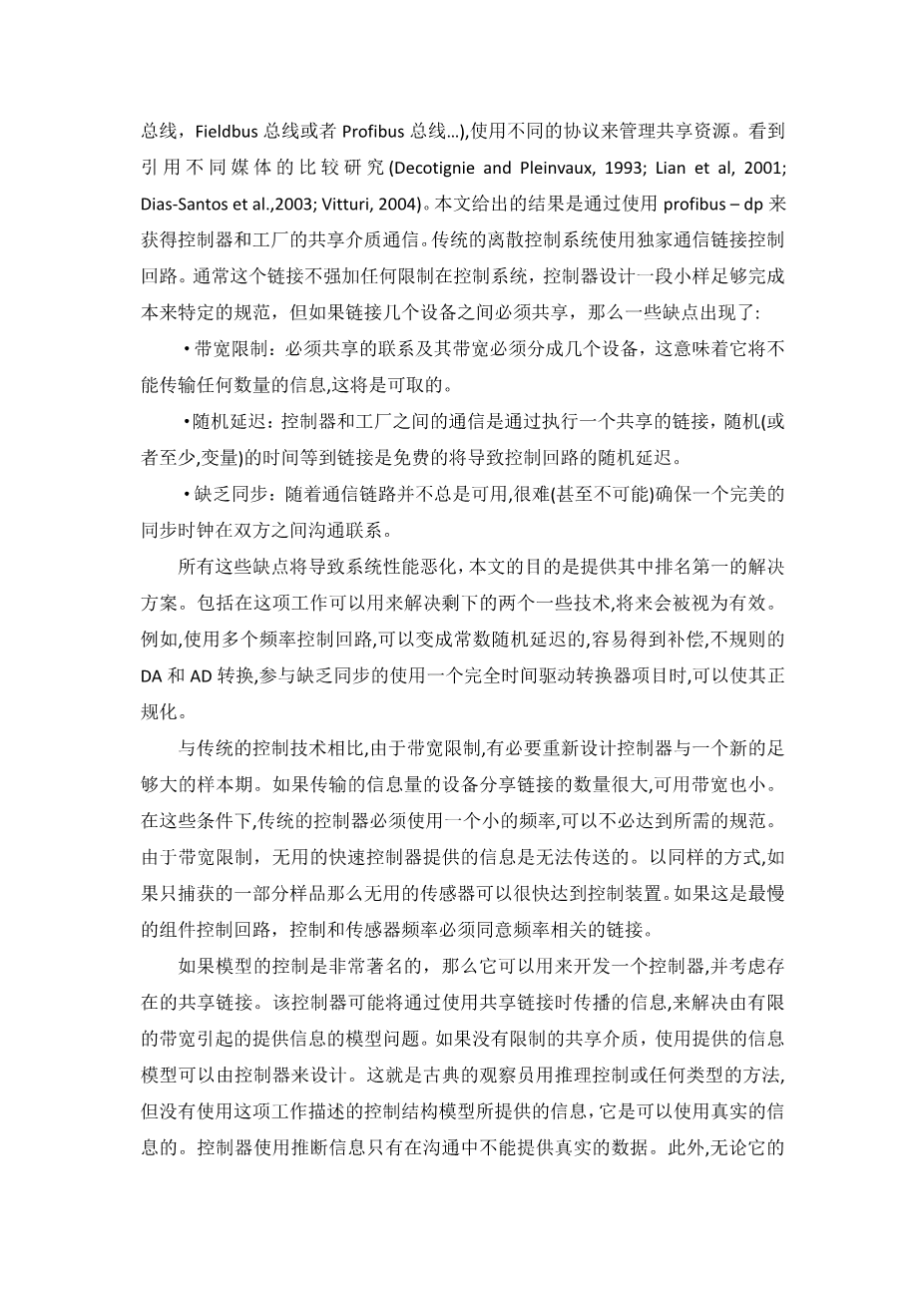NETWORKED CONTROL SYSTEMS WITH INFORMATION RECOVERY OVER PROFIBUS-DP
Abstract: The aim of this paper is to propose a control structure suitable to be used in Networked Control Systems in which the shared communication medium imposes a limitation in the amount of information that can be transmitted. In this kind of systems, the link to perform the communication between controller and plant is used to close several control loops. The bandwidth must be shared between all the sender devices and the available bandwidth for each loop is reduced as much as the number of devices using the link is increased. With conventional techniques the control frequency must be decreased to fit the available bandwidth. If the number of devices sharing the link is large, the control frequency may be not enough to reach the desired specifications. When frequency decreasing, imposed by the shared link, is present in the loop it can be modeled as a periodic system. The paper proposes control structure based on the periodic behavior of the plant, as it is seen from the point of view of the controller through the shared medium. The control is easy to be implemented and it has been designed to make the most advantage of the available bandwidth. This periodic control uses the model of the plant to supply the information that could not be sent due to the bandwidth limitations. Once the information is recovered, a conventional control designed without considering the limitations imposed by the shared medium, can be used. One of the main advantages of the proposed control is that the model of the plant, in which is based the information recovery, does not need to be linear and time-invariant. Non linear behavior, periodicity and any kind of irregularities can be included for a better recovery of the information loss. The proposed control is tested on the control of X and Y axis from a model crane, using Profibus-DP as the shared medium to close the loop. Copyright © 2008 IFAC
Keywords: Networked control, periodic control, information recovery, fieldbus, Profibus.
1. INTRODUCTION TO NETWORKED CONTROL SYSTEMS
Networked Control Systems (NCS) are known in the literature as the kind of control systems in which the communication between controller and plant is performed through a shared medium. Detailed descriptions of this kind of systems can be found in (Halevi and Ray, 1988; Ray and Halevi, 1988; Bushnell, 2001; Chow and Tipsuwan, 2001;Casanova and Salt, 2003). NCS are usually present in the industrial environment because they allow reducing the cost of implementation and maintenance by sharing the communication resource. This is particularly interesting when there are large distances to cover between the process to control and the main controller, as it is usual in large manufacturing plants. Also, when there are hard restrictions of weight or space as it is usual in aircrafts and spacecrafts, the shared link is a good choice to reduce the amount of wires. Different types of communication media can be used to implement an NCS. They can be general purpose networks (RS-232, Ethernet, Internet …) or industrial networks(DeviceNet, CAN, Fieldbus Foundation, Profibus…),using different protocols to administrate the shared resource. See references (Decotignie and Pleinvaux, 1993; Lian et al., 2001; Dias-Santos et al.,2003; Vitturi, 2004) for compared studies of different media. The results presented in this paper have been obtained using Profibus-DP as the shared medium to communicate controller and plant.A conventional discrete control system uses an exclusive communication link to close the control loop. Usually this link does not impose any limitations in the control system. The controller is designed with a small enough sample period to accomplish certain specifications. But if the link must be shared between several devices some drawbacks arises:
• Bandwidth limitation: The link must be shared and its bandwidth must be divided between several devices. This means that it is not possible to transmit any amount of information as it would be desirable.
• Random delays: The communication between controller and plant is performed through a shared link. The random (or at least, variable) amount of time waiting until the link is free will cause random delays in the control loop.
• Lack of synchronization: As the communication link is not always available, it is difficult (even impossible) to guarantee a perfect synchronicity between the clocks in both sides of the communication link.
All these drawbacks cause degradation on the system performance. The goal of this paper is to provide a solution to the first one of them. Some of the techniques included in this work can be used to solve the remaining two that will be considered in future works. For example, using more than one frequency in the control loop, the random delays can be turned into constant ones, easier to be compensated, and the irregular DA and AD conversions, involved with the lack of synchronization when using time-driven converters, can be regularized.
With conventional control techniques, due to the bandwidth limitations, it is necessary to re-design the controller with a new, large enough, sample period. If the number of devices sharing the link is large, the available bandwidth is small and also it is the amount of information to be transmitted. In these conditions,a conventional controller must use a small frequency that can be not enough to reach the desired specifications. It is useless to have a fast controller providing an amount of information that cannot be transmitted, due to the bandwidth limitations. In the same way, it is useless to have a fast sensor if only part of the captured samples can reach the control device. Control and sensor frequency must agree with the frequency associated with the link, if this is the slowest component in the control loop.<
剩余内容已隐藏,支付完成后下载完整资料


英语译文共 17 页,剩余内容已隐藏,支付完成后下载完整资料
资料编号:[484378],资料为PDF文档或Word文档,PDF文档可免费转换为Word
以上是毕业论文外文翻译,课题毕业论文、任务书、文献综述、开题报告、程序设计、图纸设计等资料可联系客服协助查找。


